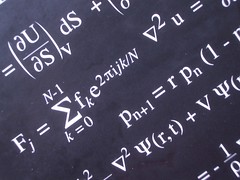 |
In two preprints Functional Analytic Issues in \(\mathbb{Z}^n_2\)-geometry and Products in the category of \(\mathbb{Z}^n_2\)-manifolds Norbert Poncin and I explore in some detail the Fréchet algebra structure on the structure sheaf of a \(\mathbb{Z}^n_2\)-manifold and use this to deduce several important results including the fact that the category of \(\mathbb{Z}^n_2\)-manifolds admits (finite) products. |
Loosley, \(\mathbb{Z}^n_2\)-manifolds are manifold-like objects for which we have local coordinates that are assigned a grading in \(\mathbb{Z}^n_2 = \mathbb{Z}_2 \times \mathbb{Z}_2 \times \cdots \mathbb{Z}_2\) (n-times) and the coordinates are \(\mathbb{Z}^n_2\)-commutative with the sign factor being given by the standard scalar product on \(\mathbb{Z}^n_2\). Note that this means that the sign factors are not determined by the parity, i.e., the sum of the components of the \(\mathbb{Z}_2^n\)-degree. In particular, we may have coordinates that anticommute but are none the less non-nilpotent. This is in stark contrast to the standard case of supermanifolds. The upshot is that we have non-nilpotent formal coordinates and must use power series and not polynomials in the formal coordinates when defining the structure sheaf. This can lead to many subtleties when developing the theory. The basic theory using locally ringed spaces is quite new [1,2] and many basic questions remain.
In the two preprints, we address some foundational issues anchored in functional analysis. Alongside other results, we have shown the following:
- The structure sheaf of a \(\mathbb{Z}^n_2\)-manifold is a nuclear Fréchet sheaf of \(\mathbb{Z}^n_2\)-graded \(\mathbb{Z}^n_2\)-commutative algebras;
- Morphisms of \(\mathbb{Z}^n_2\)-manifolds are continous with respect to the local convex topolgies on spaces of local sections;
- All the information about a \(\mathbb{Z}^n_2\)-manifold is completely encoded in the algebra of global sections of the structure sheaf – we have a reconstruction theorem and an embedding of the category of \(\mathbb{Z}^n_2\)-manifold into the (opposite) category of unital \(\mathbb{Z}^n_2\)-graded \(\mathbb{Z}^n_2\)-commutative algebras;
- The cartesian product of \(\mathbb{Z}^n_2\)-manifolds is well defined and satisfies the required universal properties to be a categorical product. Thus, the category \(\mathbb{Z}^n_2\)-manifold admits products.
While none of the above results are very surprising given that the same statements can be made for smooth manifolds and indeed supermanifolds, the non-trivial problems arise due to the fact that we are forced to deal with algebras of formal power series. Some of the proof are minor modifications of the proofs for supermanifolds (the n=1 case), while others really required a lot of work in checking things carefully.
At every stage, it seems that while \(\mathbb{Z}^n_2\)-manifolds are a non-trivial extension of supermanifolds, they do provide a nice workable example of noncommutative geometries in which one can keep a large part of one’s classical thinking – with some care. So far, the basic theory of smooth manifolds extends to the theory of \(\mathbb{Z}^n_2\)-manifolds. The exception here seems to be the theory of integration, which is already more complicated for supermanifolds as compared with classical manifolds. The interested reader may consult [3] for a review of the current state of affairs.
Now, with these results in place, it seems the right time to look for further applications of \(\mathbb{Z}^n_2\)-manifolds… watch this space!
References
[1] Covolo, Tiffany; Grabowski, Janusz; Poncin, Norbert The category of \(\mathbb{Z}^n_2\)-supermanifolds, J. Math. Phys. 57 (2016), no. 7, 073503, 16 pp.
[2] Covolo, Tiffany; Grabowski, Janusz; Poncin, Norbert Splitting theorem for \(\mathbb{Z}^n_2\)-supermanifolds, J. Geom. Phys. 110 (2016), 393–401.
[3] Poncin, Norbert Towards integration on colored supermanifolds. Geometry of jets and fields, 201–217, Banach Center Publ., 110, Polish Acad. Sci. Inst. Math., Warsaw, 2016.